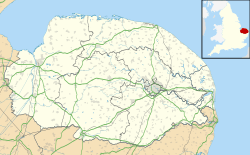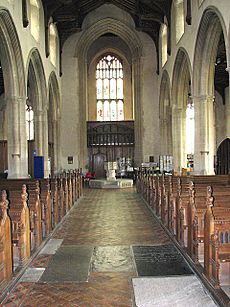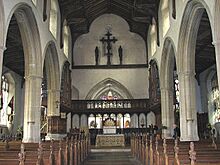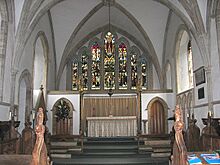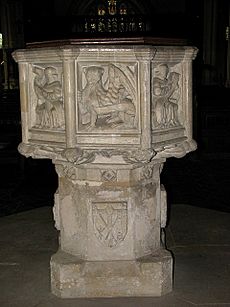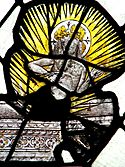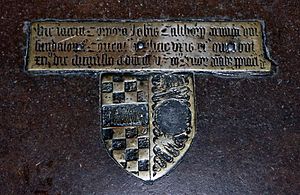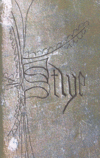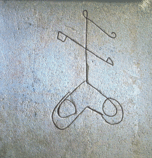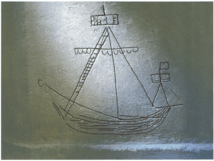St Nicholas, Blakeney facts for kids
Quick facts for kids St Nicholas |
|
|---|---|
| St Nicholas Church, Blakeney | |
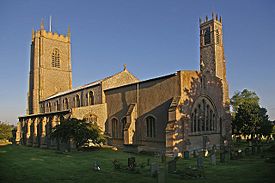
A view of the church from the south east.
|
|
| 52°57′4″N 1°1′29″E / 52.95111°N 1.02472°E | |
| OS grid reference | TG 032 435 |
| Location | Blakeney, Norfolk |
| Country | England |
| Denomination | Church of England |
| History | |
| Status | Parish church |
| Architecture | |
| Functional status | Active |
| Heritage designation | Grade I listed |
| Designated | 1959 |
| Architectural type | |
| Administration | |
| Parish | Blakeney |
| Deanery | Holt |
| Diocese | Norwich |
| Province | Canterbury |
St Nicholas is the Church of England parish church in the village of Blakeney, Norfolk. It was first built in the 13th century, but most of what you see today was built in the 15th century. At that time, Blakeney was an important seaport.
The church has a very unusual feature: two towers. The main tower is at the west end, but a second, smaller tower is at the east end. This smaller tower was used as a beacon, like a lighthouse, to guide ships safely into the port.
Other special features include the chancel (the area around the altar) with its vaulted ceiling and a unique seven-light window. The main part of the church, called the nave, has a beautiful hammerbeam roof. Because of its amazing architecture, St Nicholas is a Grade I listed building, meaning it is one of the most important historic buildings in England.
Contents
History of the Church
How It All Began
The town of Blakeney has been around since at least the Neolithic period. In the Domesday Book of 1086, it was called "Esnuterle." The name Blakeney first appeared in 1340. The first church on this site was built in the late 13th century. It was built on a hilltop, which is unusual for churches in this area.
The church was named after Saint Nicholas, the patron saint of sailors. This made sense because Blakeney was a busy port. Nearby, a Carmelite friary (a type of monastery) also had its own church.
In the 15th century, Blakeney was a wealthy town. It was one of the few ports allowed to trade valuable goods like horses, gold, and silver. With this wealth, the town decided to rebuild its church in the popular Perpendicular style. The main part of the church, the nave, and the large west tower were built in 1434. The only part of the old church they kept was the chancel.
Changes Over Time
During the English Reformation in the 16th century, many things inside the church were changed. Statues, stained glass, and other decorations were removed or destroyed. For a while, the church building was not well taken care of. Records from the 1500s show that the chancel was falling apart and the walls were in decay.
Luckily, in the 1880s, the church was carefully restored. The outside walls were refaced with knapped flint, giving it a fresh look. A wall was built behind the altar to create a separate room called a sacristy. The west tower was restored again in 1989.
More recently, in 2000, the church got a new floor, a kitchen, and a new heating system. Because the altar is far from where people sit, a second, smaller altar was added at the front of the nave. This allows for smaller, more personal services.
A Tour of the Building
St Nicholas is a large church built in the Gothic style. It has a long nave with aisles on both sides, a chancel, and its two famous towers.
The Two Towers
The main west tower is 31 meters (104 feet) tall. It has battlements and pinnacles at the top. This tower holds the church bells.
The smaller, thinner tower is at the east end of the church. It is believed to have been used as a beacon for sailors. By lining up the two towers, ships could find the safe channel into Blakeney's harbor. This is a clever navigation method called "leading lights."
Inside the Church
The nave is the main body of the church where the congregation sits. It is 30 meters (100 feet) long. Its amazing hammerbeam roof was made from oak and chestnut in the 15th century. If you look up, you can see carved angels on the ends of the wooden beams.
The chancel is from the original 13th-century church. It has a beautiful vaulted ceiling, which is rare for a church of this period. Its most striking feature is the east window, which has seven stepped lancet windows. This design is found in only two other English churches. The chancel also has three stone seats for priests, called sedilia.
Furnishings and Art
Many of the church's original medieval furnishings were lost during the Reformation. However, some beautiful items remain, and others were added during the Victorian restoration.
Carvings and Woodwork
The octagonal font dates from the 15th century. Its panels are carved with symbols of the Four Evangelists (Matthew, Mark, Luke, and John) and figures of important Church Doctors.
The pulpit, where sermons are given, was made in 1886. It was designed to match the style of the medieval font. It features carvings of the twelve Apostles.
The chancel still has four of its original choir stalls. These seats have special hinged seats called misericords. Monks could lean against them during long services. The new stalls were made to match the old ones perfectly.
Stained Glass Windows
Most of the stained glass is from the late 19th century and was made by the famous company James Powell and Sons. The large east window shows a scene called the Te Deum, a hymn of praise. The windows on the south side tell the story of the early Christian church in Britain.
During the Reformation, some of the original 15th-century stained glass was smashed and buried in the churchyard. Fragments of this glass were later found and put together in a window in the north aisle. These pieces show Christ rising from the tomb, surrounded by angels. The angels are shown wearing "feather tights", which might have been inspired by costumes from medieval plays.
There are also two modern stained glass windows from 2002. One is dedicated to the RAF and the other to the Royal National Lifeboat Institution (RNLI).
Memorials and Graffiti
Inside the church, there are many memorials to people from Blakeney's past. A brass plaque marks the grave of John Calthorpe, who was a major benefactor of the church in the 1500s.
Blakeney had a lifeboat station for almost 100 years. Several plaques on the wall honor the brave lifeboat crews and list their daring rescues. One famous rescue happened in January 1918, when the crew saved 30 people from two ships during a fierce storm.
Medieval Graffiti
Before the Reformation, people often carved graffiti into church walls. St Nicholas has a lot of this ancient graffiti, including prayers, symbols, and merchants' marks.
Most famously, there are at least 30 drawings of ships scratched into the stone pillars. These are found mainly in the south aisle, near where a side altar once stood. It is believed that sailors carved these ships as offerings to a saint, praying for a safe voyage. This was a common tradition in port towns across Europe.
You can also find mason's marks, which were special symbols used by the stonemasons who built the church to identify their work.


